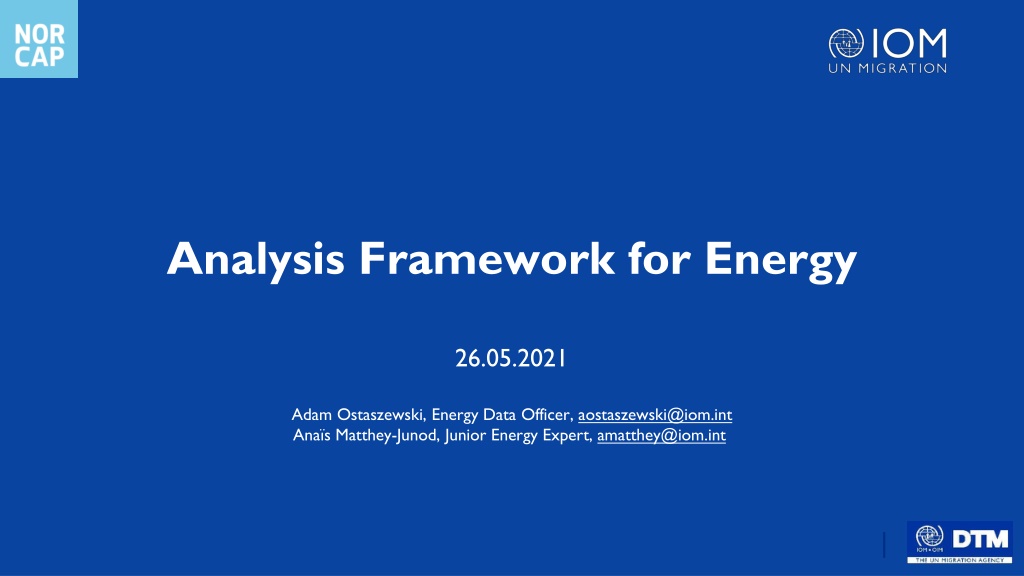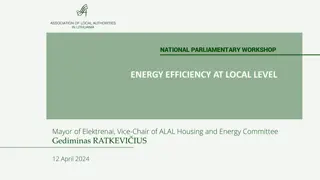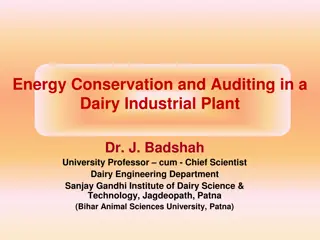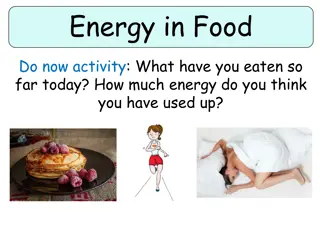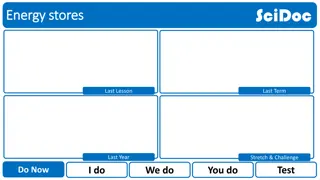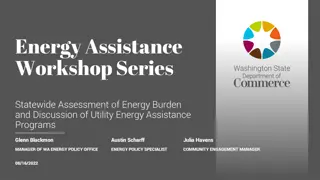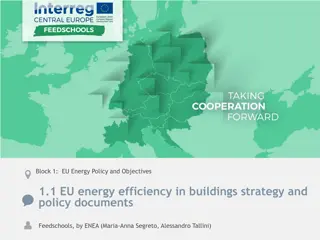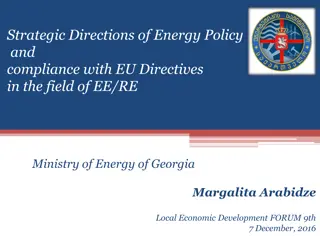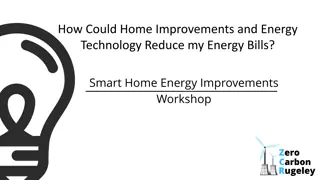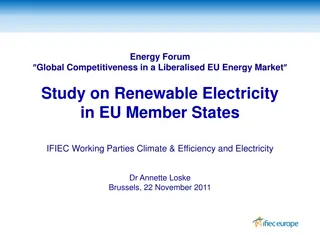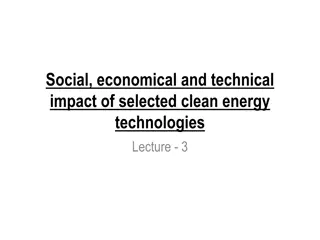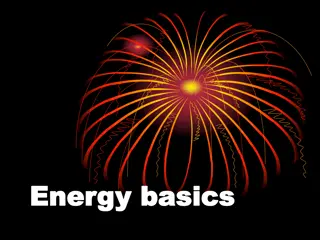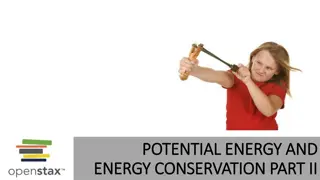Energy Analysis Framework for Safe and Sustainable Energy Usage
The Energy Analysis Framework explores the external factors and enabling environment influencing energy consumption, particularly in cooking. It addresses issues such as climate change, vulnerability to hazards, displacement, safety levels, food security, nutrition impact, and associated risks related to energy usage. The framework aims to improve health status, environmental protection, and overall well-being by considering various dimensions of energy provision and access.
Download Presentation

Please find below an Image/Link to download the presentation.
The content on the website is provided AS IS for your information and personal use only. It may not be sold, licensed, or shared on other websites without obtaining consent from the author. Download presentation by click this link. If you encounter any issues during the download, it is possible that the publisher has removed the file from their server.
E N D
Presentation Transcript
Analysis Framework for Energy 26.05.2021 Adam Ostaszewski, Energy Data Officer, aostaszewski@iom.int Ana s Matthey-Junod, Junior Energy Expert, amatthey@iom.int
Energy Analysis Framework External factors and enabling environment Environmental resources Climate change Climate and weather conditions Built environment/Shelter Political & Legal framework Outcomes Causal factors Vulnerability: Exposure, Susceptibility, and Resilience to specific hazards events or ongoing conditions Displacement: (natural, socio-economic, conflict, disease and others) Protection Shelter safety WASH facilities Community facilities Moving around site Reduced GBV incidents Well-being Reduced fuel burning Connectedness with family and community feedback impact Food Consumption Safe for Human Consumption Water Purification Safe for Human Consumption Energy - Dimensions Space heating/ cooling Energy for Cooking Electricity Lighting WASH Household air pollution Safe air quality Nutrition Reduction in malnutrition Livelihood Cost Savings Time Savings Accessibility Quality Availability Use Food security risk Environmental risk Health risk Nutrition risk Socio-Economic Risk Safety risk examples Evaluation of associated risks Evaluation of level of access (Tiers - MTF) Protection risk GBV risk
Energy Analysis Framework - Energy for Cooking External factors and enabling environment Climate and weather conditions resources Built environment/Shelter Political & Legal framework Environmental Climate change Causal factors Vulnerability: Exposure, Susceptibility, and Resilience to specific hazards events or ongoing conditions Displacement: (natural, socio-economic, conflict, disease and others) Secondary Outcomes Health Status Environmental Protection Status feedback Safety Level Protection Level Food Security Nutrition impact Energy for Cooking - Dimensions Cooking fuel Primary Outcomes Water Purification Safe for Human Consumption Cooking stove Food Consumption Safe for Human Consumption Household air pollution Safe air quality Livelihood Cost Savings Time Savings Quality Safety Availability Production Distribution Natural Resources Markets Transport Accessibility Physical Access Financial Access Social Access Use Food Preferences Food Preparation Feeding Practices Food Storage Food Safety Water Access Fuel and Stove preferences Evaluation of associated risks Evaluation of level of access (Tiers - MTF) Safety risk Food security risk Health risk Nutrition risk Environmental risk Protection risk
Energy Analysis Framework - Access to Electricity and Lighting External factors and enabling environment Climate and weather conditions resources Built environment/Shelter Political & Legal framework Environmental Climate change Causal factors Vulnerability: Exposure, Susceptibility, and Resilience to specific hazards events or ongoing conditions Displacement: (natural, socio-economic, conflict, disease and others) Secondary Outcomes Environment al Protection Reduced wood foraging and burning feedback Education Lighting and time savings support youth education Safety Level Reduced fire risks Health Status Improved air quality impact Access to Electricity and Lighting - Dimensions Electric Appliances Charging & ICT Lighting Primary Outcomes Personal Uses Shelter Lighting Street Lighting Productive Uses Telecommunications, banking, etc. Protection Shelter safety WASH facilities Community facilities Moving around site Reduced GBV incidents Well-being Reduced fuel burning Connectedness with family and community Livelihoods Cost Savings Time Savings Increased sources of income Availability Tech Installation Energy Distribution App. Distribution Natural Resources Markets Transport Accessibility Physical Access Financial Access Social Access Quality Safety Relability Use System maintenance App. Usability & Preferences Safety & Fire Risks Fuel sourcing Socio-Economic Risk Environmental risk Health risk GBV risk Safety risk Evaluation of associated risks Evaluation of level of access (Tiers - MTF) Protection risk
Energy Analysis Framework - Energy for Thermal Comfort (Space Heating and Cooling) External factors and enabling environment Climate and weather conditions resources Built environment/Shelter Political & Legal framework Environmental Climate change Causal factors Vulnerability: Exposure, Susceptibility, and Resilience to specific hazards events or ongoing conditions Displacement: (natural, socio-economic, conflict, disease and others) Secondary Outcomes feedback Health Status Hypothermia Dehydration Burns Safety Level Fire Environmental Protection Wood foraging impact Energy for Thermal Comfort - Dimensions Heating Cooling Passive e.g. winterisation (blankets, insulation, etc.) Primary Outcomes Space Heating Fuel Air Circulation Device Space Cooler Space Heating Stove Household air pollution Safe air quality Well-being Comfortable temperature Quality Safety Relability Availability Production Distribution Natural Resources Markets Transport Accessibility Physical Access Financial Access Social Access Use Fuel and Stove Preferences Fuel and Stove Safety Cooling Devices Preferences Evaluation of associated risks Evaluation of level of access (Tiers - MTF) Health risk Environmental risk Safety risk
Energy Analysis Framework - Energy for WASH (Water, sanitation and hygiene) External factors Climate and weather conditions resources Built environment/Shelter Environmental Causal factors Climate change Vulnerability: Exposure, Susceptibility, and Resilience to specific hazards events or ongoing conditions Displacement: (natural, socio-economic, conflict, disease and others) Secondary Outcomes Environmental Protection Waste reduction GHG reduction Child Protection SGBV Food security Agriculture Cooking feedback impact Energy for WASH - Dimensions Water pumping Water delivery Water purification Waste management Primary Outcomes Health Status Disease control WASH-related mortality Nutrition Reduction in malnutrition Livelihoods Time saving Irrigation for subsistence farming Quality Safety Human resources Reliability Availability Production Infrastructure & Facilities Stock/ Reserve Markets Transport Use Knowledge/ Practice Collection/ Distribution Consumption Disposal Accessibility Physical Access Financial Access Social Access Evaluation of associated risks Evaluation of level of access (Tiers - MTF) Health risk Environmental risk Food security risk Nutrition risk
